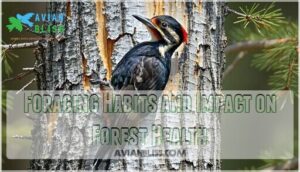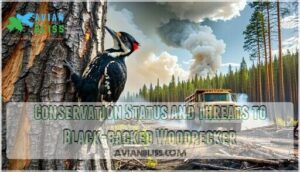This site is supported by our readers. We may earn a commission, at no cost to you, if you purchase through links.

This medium-sized bird thrives in fire-damaged areas, using its powerful bill to extract wood-boring beetle larvae from charred trees.
Unlike most woodpeckers, males have yellow crown patches while females don’t.
They’re specialized firefighters of the forest, turning ecological disasters into dining opportunities.
These birds prefer recently burned coniferous forests across Canada and the western United States.
Their population remains stable at around 1.7 million, though habitat loss poses growing concerns.
Understanding their unique lifestyle reveals nature’s remarkable adaptation strategies.
Table Of Contents
- Key Takeaways
- Description and Physical Characteristics of Black-backed Woodpecker
- Habitat and Behavior of Black-backed Woodpecker
- Foraging Habits and Impact on Forest Health
- Conservation Status and Threats to Black-backed Woodpecker
- Frequently Asked Questions (FAQs)
- Where do Black-backed Woodpeckers live?
- What is the difference between a black-backed woodpecker and a hairy woodpecker?
- Are Black-backed Woodpeckers aggressive?
- Why are they called Black-backed Woodpeckers?
- What are the nesting habits of Black-backed Woodpeckers?
- Where can Black-backed Woodpeckers be found year-round?
- How long do black-backed woodpeckers live?
- Do they migrate during winter months?
- What predators threaten black-backed woodpeckers?
- How many eggs do they typically lay?
- Conclusion
Key Takeaways
- You’ll find these specialized woodpeckers thriving in recently burned coniferous forests – they’re perfectly adapted with three-toed feet and shock-absorbent skulls to excavate charred trees across Canada and the western United States.
- They’re nature’s pest controllers in fire-damaged areas – you can watch them methodically scale bark to extract wood-boring beetle larvae, preventing pest outbreaks that could harm surviving trees and supporting forest recovery.
- You can identify them by their distinctive black backs and yellow crown patches on males – they’re medium-sized birds with white underparts that stand out against charred forest backgrounds, unlike typical four-toed woodpeckers.
- Their survival depends on protecting burned forest habitats – you’ll need to support conservation efforts that limit fire suppression and salvage logging, as these practices destroy the dead trees they require for nesting and foraging.
Description and Physical Characteristics of Black-backed Woodpecker
When you spot a black backed woodpecker, you’ll notice its medium-sized frame measuring 9.1 inches long with a distinctive bird size and shape comparable to a robin.
Size comparison reveals it’s larger than a Downy Woodpecker but smaller than a Northern Flicker.
The bird color pattern features glossy black plumage across the back, head, and wings, contrasting with white underparts and plumage details including small white wing spots and black-and-white barring on the flanks.
Males display a bright yellow crown patch while females show entirely black crowns.
The bill morphology presents a sturdy, chisel-like structure perfect for bark excavation.
This bird species showcases remarkable skull adaptations – the most shock-absorbent design in the Picoides genus, protecting against repeated wood pounding.
Most remarkably, the three-toed adaptation (two forward, one back) enhances excavation efficiency compared to typical four-toed woodpeckers.
These bird measurements include a wingspan of 15.8-16.5 inches and weight of 2.1-3.1 ounces.
Their plumage is similar to other black and white woodpeckers.
Habitat and Behavior of Black-backed Woodpecker
You’ll find the Black-backed Woodpecker thriving in post-fire habitat across North America’s boreal forest regions.
These remarkable birds don’t migrate but make irruptive movements following fire patterns and resource availability. Their woodpecker habitat preferences center on recently burned areas where dead conifers provide ideal nesting opportunities.
Notably, these birds share their habitat with others. Their unique three-toed feet and shock-absorbent skulls make them perfectly adapted for excavating in fire-damaged wood, creating essential connections between wildfire cycles and forest recovery.
Key behavioral traits you’ll observe:
- Nesting habits: Excavate cavities 2-15 feet high in charred tree trunks
- Territorial calls: Sharp "kyik" notes and complex "scream-rattle-snarl" vocalizations
- Mating rituals: Aggressive displays with harsh calls during breeding season
- Bird behavior: Solitary except when breeding, with males traveling farther for food
These specialized woodpeckers stay within burned areas year-round, shifting locations as forests regenerate.
Foraging Habits and Impact on Forest Health
Understanding the Black-backed Woodpecker’s behavior reveals fascinating insights into their specialized foraging habits. You’ll observe these birds methodically scaling bark from fire-killed conifers, targeting beetle larvae with remarkable precision.
Their foraging efficiency peaks in recently burned forests where woodboring beetles thrive. The woodpeckers’ survival is threatened by post-fire salvage logging, which reduces their habitat.
| Forest Condition | Primary Prey | Foraging Success |
|---|---|---|
| Recently burned (1-2 years) | Cerambycidae larvae | High |
| Mature burned (3-5 years) | Mixed beetle species | Moderate |
| Green forest | Bark beetles | Low |
| Salvage-logged areas | Limited insects | Very low |
This bark scaling behavior benefits forest health substantially. By controlling beetle populations, woodpeckers prevent pest outbreaks that could damage surviving trees. Their post-fire diet creates a natural balance, supporting forest regeneration.
Each cavity they excavate accelerates decomposition, recycling nutrients back into the ecosystem. Their woodpecker diet directly influences forest recovery patterns, making them essential partners in maintaining healthy woodland communities.
Conservation Status and Threats to Black-backed Woodpecker
The Black-backed Woodpecker faces significant conservation challenges despite its current IUCN status of Least Concern. You’ll find that Habitat Loss represents the species’ greatest threat, primarily driven by two human activities that disrupt their specialized lifestyle.
Despite its stable conservation status, the Black-backed Woodpecker battles habitat loss from fire suppression and salvage logging practices.
Fire Suppression policies have dramatically reduced the burned forest habitats these birds depend on. When natural fires don’t occur, the dead and dying trees that provide nesting sites and food sources become scarce. Even more devastating is Salvage Logging, which removes fire-killed trees that Black-backed Woodpeckers need for survival.
Climate Change adds another layer of complexity, potentially altering:
- Insect population dynamics and availability of wood-boring beetles
- Fire frequency patterns that could initially help but eventually harm the species.
Population Trends remain stable across most of their range, but regional variations exist. Bird conservation efforts now focus on protecting post-fire habitats and limiting timber extraction. A study suggests harvesting has a greater impact than climate change before 2080. Bird conservation status assessments show the species requires targeted bird conservation strategies to maintain viable populations as environmental pressures intensify.
Frequently Asked Questions (FAQs)
Where do Black-backed Woodpeckers live?
You’ll find these specialized woodpeckers thriving in northern North America’s boreal and montane coniferous forests.
They prefer burned forests, dead or dying conifers, and areas with beetle-infested trees across Canada, Alaska, and northwestern/northeastern United States, where they can be found in coniferous forests.
What is the difference between a black-backed woodpecker and a hairy woodpecker?
Scientists found that 95% of Black-backed Woodpeckers thrive in burned forests.
You’ll notice key differences: Black-backed Woodpeckers have three toes (not four), yellow crown patches on males, and exclusively prefer charred conifers, while Hairy Woodpeckers inhabit diverse forests with traditional four-toed feet.
Are Black-backed Woodpeckers aggressive?
Yes, Black-backed Woodpeckers display aggressive behaviors.
You’ll notice them using "aggressive displays with complex harsh calls" during territorial disputes and courtship interactions.
They’re particularly defensive when protecting their nesting cavities and foraging territories in burned forests.
Why are they called Black-backed Woodpeckers?
You’ll recognize them by their distinctive glossy black back and wings that shine against charred forest backgrounds.
This striking dark plumage perfectly matches their preferred burned forest habitat, making the name quite literal and descriptive.
What are the nesting habits of Black-backed Woodpeckers?
Picture yourself peering into a charred forest where you’ll spot these woodpeckers excavating nest cavities in dead conifers.
They’ll dig holes 2-15 feet high, with both sexes working together for about 25 days, which is a complete concept of cooperation in their nesting behavior.
Where can Black-backed Woodpeckers be found year-round?
You’ll find these woodpeckers year-round across northern North America’s boreal coniferous forests, including Canada, Alaska, northwestern and northeastern United States. They’re non-migratory but shift locations following fires and forest disturbances.
How long do black-backed woodpeckers live?
Time flies when you’re having fun, but woodpecker lifespans aren’t well-documented.
Black-backed woodpeckers’ lifespan isn’t determined, but closely related three-toed woodpeckers live at least 6-8 years.
You can expect similar longevity for these specialized forest dwellers.
Do they migrate during winter months?
Black-backed woodpeckers don’t truly migrate during winter.
They’re non-migratory but shift locations following food sources and habitat changes.
Eastern populations occasionally move southward during harsh winters, seeking better foraging conditions in burned or beetle-damaged forests.
What predators threaten black-backed woodpeckers?
Several predators threaten you’ll find targeting these woodpeckers.
Hawks and owls hunt adults during foraging.
Martens, weasels, and squirrels raid nests for eggs and chicks.
Snakes also climb trees to access vulnerable nestlings in cavities.
How many eggs do they typically lay?
You’ll typically find 3-4 eggs in their nests, though clutches can range from 2- Both parents incubate these white eggs for about 12-14 days before hatching occurs.
Conclusion
Looking through nature’s lens, you’ll find the black-backed woodpecker perfectly designed for post-fire recovery.
These specialized birds turn forest disasters into opportunities, helping burned ecosystems regenerate while controlling beetle populations.
Their unique adaptations make them essential firefighters of the wilderness.
You can support their conservation by advocating for natural fire cycles and protecting burned forest habitats.
The black-backed woodpecker proves nature’s remarkable resilience and interconnected balance.





